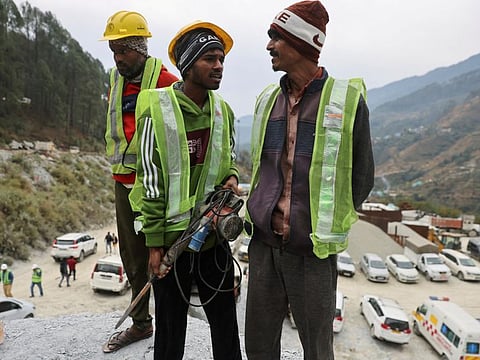‘Rat miners’ to the rescue: How 41 trapped India tunnel workers were saved
Primitive, hazardous and controversial method was banned by a Tribunal in India in 2014

Dubai: When heavy machinery broke down trying to break through the debris trapping 41 workers in a tunnel in the Indian Himalayas, authorities called in a group of people whose profession is effectively banned in the country - “rat-hole mining”.
While augur machines managed to horizontally drill through nearly three-quarters of the debris, it fell on half a dozen miners adept at burrowing in tight spaces to reach the trapped workers on Tuesday.
Rescuers successfully pulled out the workers in wheeled stretchers through a wide pipe that was pushed through the debris after a 17-day ordeal.
“It was a difficult task, but for us nothing is difficult,” said a beaming Firoz Qureshi, one of the miners, standing with his fellow workers outside the tunnel, their faces patched with white dust after overnight drilling.
The “rat miners” started working late on Monday after a second drilling machine also broke down with 15 metres out of 60 metres still left to reach the trapped men.
They worked in two teams of three each, with one person drilling, the second collecting the debris and the third pushing it out of the pipe.
They said they had worked for more than 24 hours.
“When we saw them inside the tunnel after the breakthrough, we hugged them like they were family,” said Nasir Hussain, one of the six miners.
So what exactly is rat-hole mining?
“Rat-hole mining” is a primitive, hazardous and controversial method used in India mostly to remove coal deposits through narrow passages. The name comes from its resemblance to rats burrowing through narrow holes.
This technique is used mostly in Northeastern states of India to extract coal from narrow, horizontal seams.
The term “rat hole” refers to the narrow pits dug into the ground, typically just large enough for one person to descend and extract coal.
These rat holes can be dug both vertically and horizontally.
In this method very small pits, not more than 4 feet wide are dug. Once the miners reach the coal seam, tunnels are made sideways to extract the coal.
What are the tools used by rat miners?
In rat-hole mining, workers enter the mines and use hand-held tools to dig. This is the most common method of mining in Meghalaya, where the coal seam is very thin and any other method risks being economically unviable.
The small size of the tunnels make children the best fit for the hazardous job, and in a state that has limited options for livelihood, many line up for the risky job.
Many children also pose as adults to get work in such mines.
How does it work?
Three people will go inside the tunnel: One will do the drilling, the other will collect muck and the third one will push the muck through the trolley.
Once the pits are dug, miners descend using ropes or bamboo ladders to reach the coal seams. The coal is then manually extracted using primitive tools such as pickaxes, shovels, and baskets.
“We have been doing it for more than 10 years and there’s enough space for us. The 41 men are also labourers and we all want to bring them out,” one rat miner told Reuters on Monday.
Rat-hole mining is illegal in many countries due to increasing cases of miners dying from asphyxiation, lack of oxygen and hunger.
Uttarakhand government’s nodal officer Neeraj Khairwal made it clear that the men brought to the site were not rat-hole miners but people who are experts in the technique, news agency PTI reported.
What are the risks associated with rat-hole mining and when was it banned?
Rat-hole mining is largely unregulated and miners have to work without proper ventilation, safety gears and any structural support.
The National Green Tribunal banned rat-hole mining in 2014 for being unscientific, but the practice continues to be rampant. Several accidents have resulted in deaths of rat-hole miners in the Northeastern state, NDTV reported.
In 2018, 15 men involved in illegal mining were trapped inside a flooded mine. Only two bodies could be recovered in the course of the rescue operation that lasted for more than two months.
Another such accident took place in 2021 when five miners were trapped in a flooded mine. Three bodies were found before rescue teams called off the operation after a month. Add to this the environmental pollution caused by this method.
Mining, however, is a key source of revenue for the state government. The Manipur government has challenged the NGT ban, arguing that there is no other feasible mining option for the region.
A panel appointed by Meghalaya High Court in 2022 found rat-hole mining continues unabated in Meghalaya, according to NDTV.
Why was the tunnel being dug in Uttarakhand?
The tunnel digging which led to the miners being trapped is part of the $1.5 billion Char Dham highway, one of Prime Minister Narendra Modi’s most ambitious projects, aimed at connecting four Hindu pilgrimage sites through 890km of roads.
Authorities have not said what caused the cave-in but the region is prone to landslides, earthquakes and floods.
The tunnel did not have an emergency exit and was built through a geological fault, a member of a panel of experts investigating the disaster told Reuters on Friday. -- Inputs from Reuters
Sign up for the Daily Briefing
Get the latest news and updates straight to your inbox






